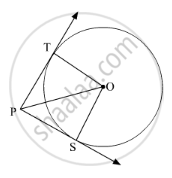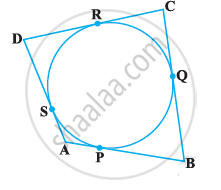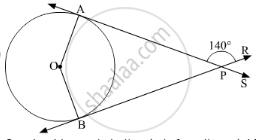Advertisements
Advertisements
Question
In Fig. 2, from a point P, two tangents PT and PS are drawn to a circle with centre O such that ∠SPT = 120°, Prove that OP = 2PS ?

Solution
It is given that PS and PT are tangents to the circle with centre O. Also, ∠SPT = 120°.
To prove: OP = 2PS
Proof: \[In ∆ PTO\ and ∆ PSO,\]
PT = PS (Tangents drawn from an external point to a circle are equal in length.)
TO = SO (Radii of the circle)
∠PTO = ∠PSO = \[90^o\]
Thus,
∠TPO = ∠SPO =\[\frac{120^o}{2} = 60^o\]
Now, in \[∆ PSO,\]
\[\cos60^o = \frac{PS}{PO}\]
\[ \Rightarrow \frac{1}{2} = \frac{PS}{PO}\]
\[ \Rightarrow PO = 2PS\]
APPEARS IN
RELATED QUESTIONS
In the following Fig, a quadrilateral ABCD is drawn to circumscribe a circle, with centre O, in such a way that the sides AB, BC, CD and DA touch the circle at the points P, Q, R and S respectively. Prove that AB + CD = BC + DA.

If from an external point P of a circle with centre O, two tangents PQ and PR are drawn such that ∠QPR = 120°, prove that 2PQ = PO.
Prove that a parallelogram circumscribing a circle is a rhombus.
Prove that the angle between the two tangents drawn from an external point to a circle is supplementary to the angle subtended by the line segments joining the points of contact to the centre.
Prove that the perpendicular at the point of contact to the tangent to a circle passes through the centre.
Two concentric circles are of radii 5 cm and 3 cm. Find the length of the chord of the larger circle which touches the smaller circle.
Find the angle between two radii at the centre of the circle as shown in the figure. Lines PA and PB are tangents to the circle at other ends of the radii and ∠APR = 140°.

The length of a tangent drawn from a point at a distance of 10 cm of the circle is 8 cm. The radius of the circle is ______
In a circle of radius 5 cm, AB and AC are the two chords such that AB = AC = 6 cm. Find the length of the chord BC.
Two concentric circles with centre O are of radii 3 cm and 5 cm. Find the length of chord AB of the larger circle which touches the smaller circle at P.

